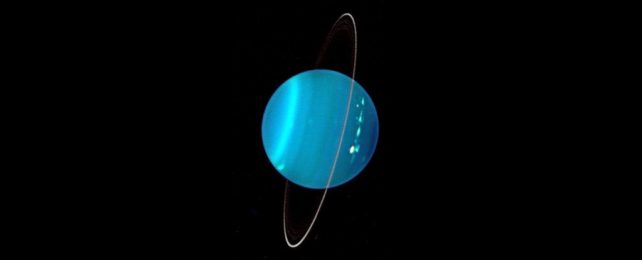Uranus marches to the beat of its own weird little drum.
Although it shares many similarities with our Solar System's other ice giant, Neptune, it has a bunch of quirks that are all its own.
And one of these is impossible to miss: Its rotational axis is so skewed it may as well be lying down. That's a whopping tilt of 98 degrees from the orbital plane.
And, to top it all off, it's rotating clockwise – the opposite direction from most of the other planets in the Solar System.
A new study has found a plausible explanation for this weird behavior: A moon migrating away from the planet, resulting in Uranus being pulled over onto its side. And it wouldn't even need to be a big moon. Something half the mass of our own Moon could have done it, although a larger moon would be the more likely contender.
The reasoning has been laid out in a paper led by astronomer Melaine Saillenfest of the National Centre for Scientific Research in France. This paper, not yet peer-reviewed, has been accepted into the journal Astronomy & Astrophysics and made available on preprint resource arXiv.
Scientists have come up with models to explain this weird behavior, such as a massive object that collided with Uranus and literally smacked it sideways, but the more favored explanation is a bunch of smaller objects.
However, this hypothesis raises issues that are even more difficult to explain: namely, those pesky similarities to Neptune.
The two planets have extremely similar masses, radii, rotation rates, atmosphere dynamics and compositions, and wacky magnetic fields. These similarities suggest that the two planets could have been born together, and they become much more difficult to reconcile when you throw planet-tipping impacts into the mix.
This has led scientists to seek other explanations, such as a wobble that could have been introduced by a giant ring system or a giant moon early in the Solar System's history (albeit with a different mechanism).
But then, a few years ago, Saillenfest and his colleagues found something interesting about Jupiter. Thanks to its moons, the gas giant's tilt could increase from its current slight 3 percent to around 37 percent in a few billion years, thanks to the outward migration of its moons.
Then they took a look at Saturn and found that its current tilt of 26.7 degrees could be the result of the rapid outward migration of its largest moon, Titan. This could have happened, they found, almost without having any effect on the planet's spin rate.
Obviously, that raised questions about the most tilted planet in the Solar System. So the team performed simulations of a hypothetical Uranian system to determine whether a similar mechanism could explain its peculiarities.
It's not unusual for moons to migrate. Our own Moon is currently moving away from Earth at a rate of about 4 centimeters (1.6 inches) per year. Bodies orbiting a mutual center of gravity exert a tidal force on each other that gradually causes their rotations to slow. In turn, this loosens gravity's grip so that the distance between the two bodies widens.
Turning back to Uranus, the team performed simulations with a range of parameters, including the mass of the hypothetical moon. And they found that a moon with a minimum mass of around half that of Earth's Moon could tilt Uranus towards 90 degrees if it migrated by more than 10 times the radius of Uranus at a rate higher than 6 centimeters per year.
However, a larger moon with a size comparable to Ganymede was more likely, in the simulations, to produce the tilt and spin we see in Uranus today. However, the minimum mass – about half an Earth Moon – is about four times the combined mass of the current known Uranian moons.
The work accounts for this, too. At a tilt of about 80 degrees, the moon became destabilized, triggering a chaotic phase for the spin axis that ended when the moon ultimately collided with the planet, effectively "fossilizing" Uranus' axial tilt and spin.
"This new picture for the tilting of Uranus appears quite promising to us," write the researchers.
"To our knowledge, this is the first time that a single mechanism is able to both tilt Uranus and fossilize its spin axis in its final state without invoking a giant impact or other external phenomena. The bulk of our successful runs peaks at Uranus's location, which appears as a natural outcome of the dynamics," they continue.
"This picture also seems appealing as a generic phenomenon: Jupiter today is about to begin the tilting phase, Saturn may be halfway in, and Uranus would have completed the final stage, with the destruction of its satellite."
It's not clear whether Uranus could have hosted a moon large enough and at a high enough migration rate to produce this scenario, and it will, the researchers say, be challenging to show with observations.
However, a better understanding of the current rate of migration for Uranus's moons would go a significant way towards resolving these questions. If they are migrating at a high rate, this could mean that they formed from the debris of the ancient moon following its destruction many eons ago.
Bring on that Uranus probe.
The research has been accepted into Astronomy & Astrophysics and is available on arXiv.
